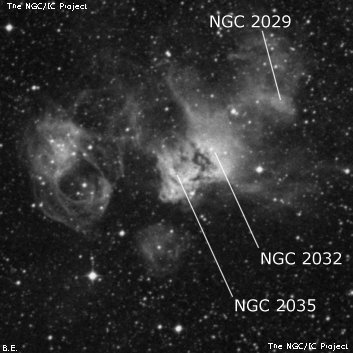
James Dunlop probably discovered NGC 2035 = D 219 on 27 Sep 1826 and described a "pretty bright round nebula, about 1 1/4' diameter, bright towards the centre". He states 2 observations were made and his published position is within the Seagull Nebula complex. As NGC 2032/2035 are the brightest sections, this identification seems reasonable.
JH first observed this bright nebula on 23 Dec 1834 and called NGC 2035 = h2916, "B, L, bM. The 3rd of three which run together. (Plate III, fig 5)". On his next observation he recorded "pB, L, R. The third of 3 which run together." Herschel gave an uncertain equivalence with D 220 in the CGH.
600/800mm - 24" (4/11/08 - Magellan Observatory, Australia): this is the southeast section of the bright Seagull Nebula in the LMC. At 200x using a UHC filter it appeared very bright, moderately large, with a very irregular shape similar to an anvil. The very knotty, complex structure was elongated N-S, 1.6'x1.0', with the widest part of the anvil on the south end. NGC 2032, another very bright section, is very close preceding (roughly 1.6' between centers) and the two sections are separated by a dark lane oriented SSW-NNE. A very faint streamer attached on the NE side flows to the north NGC 2032 has a similar but brighter streamer). A fairly small detached patch, ~1.2' in diameter, is close SE (identified as LHA 120-N 59C in SIMBAD).
Notes by Steve Gottlieb